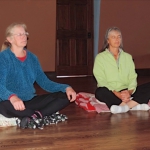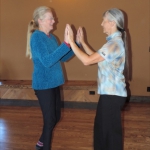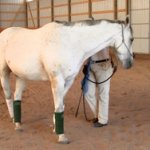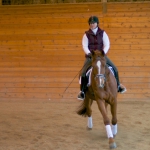Awareness and Mindfulness Exploration
1) Stillness and presence
Stillness discovery focuses on allowing our minds to slow down and become more focused on the present moment. The definitions and subtle differences between awareness and mindfulness will be explored. Soulful leadership will be discussed. Karen shares her journey into the world of chakra energy and how this has helped her on her journey to connect at a deeper level with horses. Qui Gong and Thai Chi will be examined as possible ways to connect and release energy flows within the body.
2) Physical Self Discovery
Karen follows a holistic philosophical approach that helps to create physical awareness within the rider. Riders will improve their own comfort and the comfort for their horses by becoming more balanced, symmetrical, supple and fit. Rider biomechanics (the study of how the human anatomy can connect to the horse’s movement) are incorporated into the exercises. There is a lecture focusing on rider biomechanics followed by specific exercises that help riders improve their balance, alignment, body awareness, flexibility, rhythm, and overall fitness. Dancing, as partners, will be explored. Through dancing with others we can feel what is is to lead and to follow and to find a sense of feel and timing that helps rider’s to connect to their horse’s movement.
The exercises and activities use props that include: Balimo chairs, hula hoops, BodyBlades, scales, exercise balls, Bosu Balls, medicine balls, balance boards, and integrative bands. The program is designed for lots of exploration, fun and laughter.
Areas to be explored:
- Fitness
- Balance
- Alignment
- Weight Distribution
- Flexibility
- Dexterity
- Energy
- Stamina
- Relaxation
- Breathing
- Rhythm
- Coordination
- Partnering
- Emotions
- Feel
- Timing
3) Refined Liberty Work
Horses are herd animals that work within the hierarchy of dominating or being dominated. In the natural herd there are leaders and followers. There is no middle ground. The hierarchy is always changing by successful challenges by lesser stallions and mares to become the new leaders. A horse will leave or fend for itself if it feels that there is a lack of leadership. For humans to be safe around these half-ton plus reactive animals, we need to become their leaders. When humans lead, the horse can relax into the secondary role of follower. To successfully become a horse’s leader and to connect on a communicative level, we need to be courageous, compassionate, connected, aware, and mindful leaders – leaders that lead from our souls.
“At the deepest level, a leader is the symbolic soul of the group. His role is to fulfill the needs of others and, when each need is met, to lead the group on to fulfill ever higher needs, lifting the group’s potential at every step. The inspired leader’s power base comes not from other people but from her very being, and the path she walks is guided by her own soul. Its hallmarks are creativity, intelligence, organizing power, and love.” Chopra, Deepak (2010-12-28). The Soul of Leadership: Unlocking Your Potential for Greatness (p. 10). Crown Publishing Group. Kindle Edition.
Through liberty work, one can explore different leadership styles and skills. This setting allows the horse to choose to seek out and follow a strong leader or to leave if the horse feels abandoned and has to defend itself on its own. Horses are very aware of the different energies that arise from humans –leadership, courage, fear, tension, and domination without compassion. Horses positively respond and seek out Soul Leadership that embraces courage, compassion and connection and move away or disappear inside from fear, tension, and domination.
During the retreat, Soul Leadership qualities and skills will be discussed. To be leaders for our horses we need to feel grounded and sure of ourselves. We need to be centered as generous beings that are there to support the horses so that the horses can trust and follow and choose to willingly be in our presence.
4) Refined Groundwork
Refined Performance Horsemanship Groundwork exercises provide the rider with a fresh perspective on how their horse moves and a deeper awareness of tensions within the horse. This awareness adds an important dimension to the rider’s understanding of their horse’s body, and the suppling, strengthening, balancing, and conditioning the horse needs to perform well. Partnering (dancing) with your horse on the ground helps the rider to understand how the horse moves and to work on feel and timing. Groundwork allows the handler to refine his or her skills and aids. An equine biomechanics lecture provides additional understanding of the horse’s anatomy and natural way of moving and how different training techniques can encourage healthy posture and help reduce lameness issues. Riders leave the retreat with new tools that they can use at home to school a green horse, relax a mount prior to riding, reduce lameness while improving performance, and most importantly improve their equine partnership.
5) Taking new and expanded awareness and mindfulness into the saddle
Riders will practice being aware of what they are asking of their horse and mindful of how they are asking their horse to do different exercises. Special attention will be focused on how the horse reacts to each aid that is given. As riders become aware of their own bodies and how they function, they are better at understanding how to control their bodies on a moving horse and how to ask with aids that are timely and thoughtful. A biomechanically healthy posture for the horse and riding position is explored that helps create better performance in the horse as the horse’s natural movements are enhanced. Often behavioral issues and chronic soreness in a horse will disappear with a healthy equine and rider posture. Conditioning plans to ensure the fitness of our equine athletes will also be discussed
Group Discussion
Following each step the group gathers to discuss and share their experiences. The retreat schedule provides sufficient time to for in-depth discussion on how by focusing on awareness and mindfulness we create a better communication and partnership with our horse. The informal group discussions provide the time and “safe” environment for participants to share their thoughts and questions on the topics being discussed.
In addition, time during meals and the evening social gatherings allow the participants to get to know each other outside of the horse environment setting. This facilitates the development of trust and teamwork within the group. Often long-time friendships are formed.




